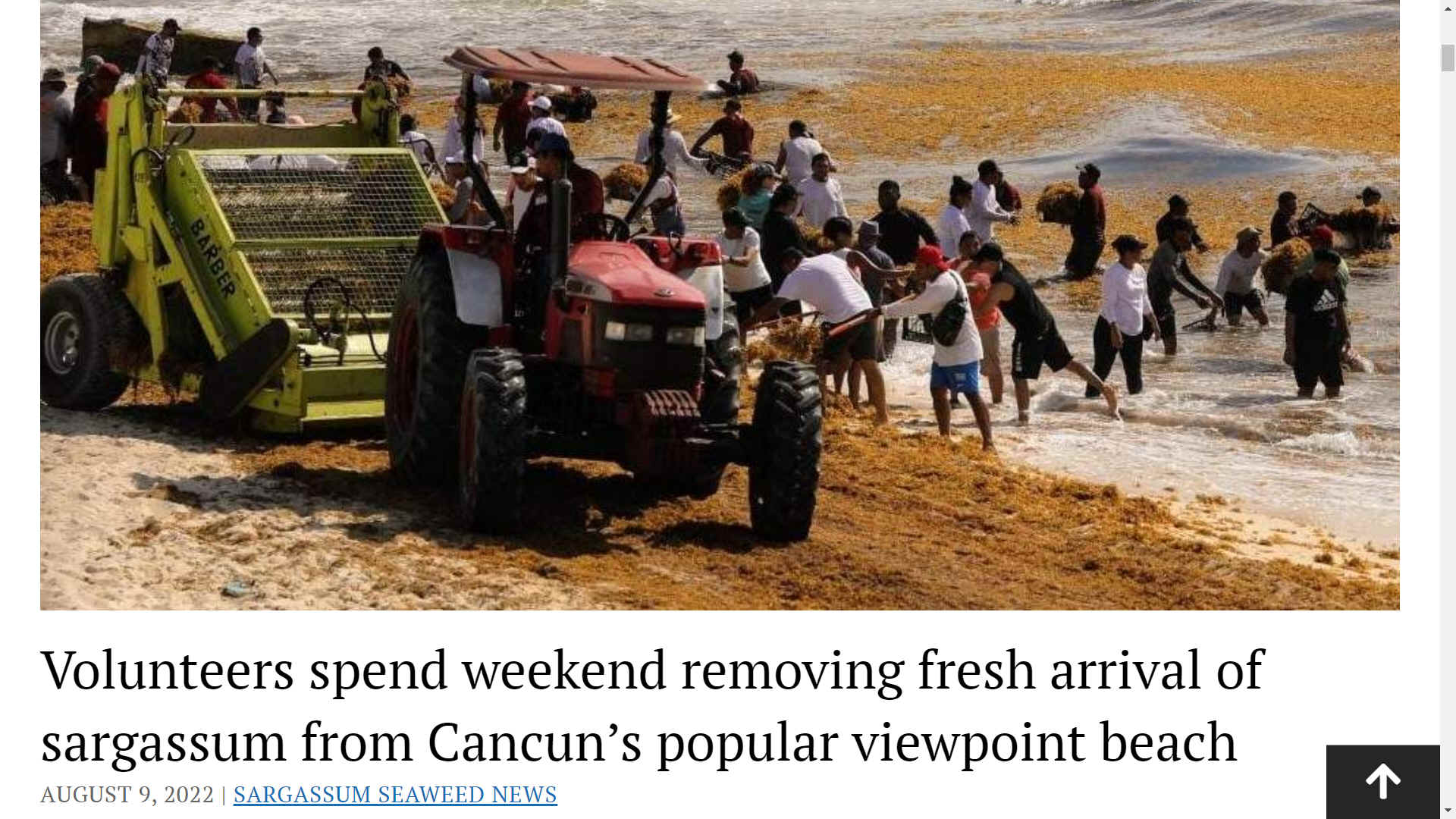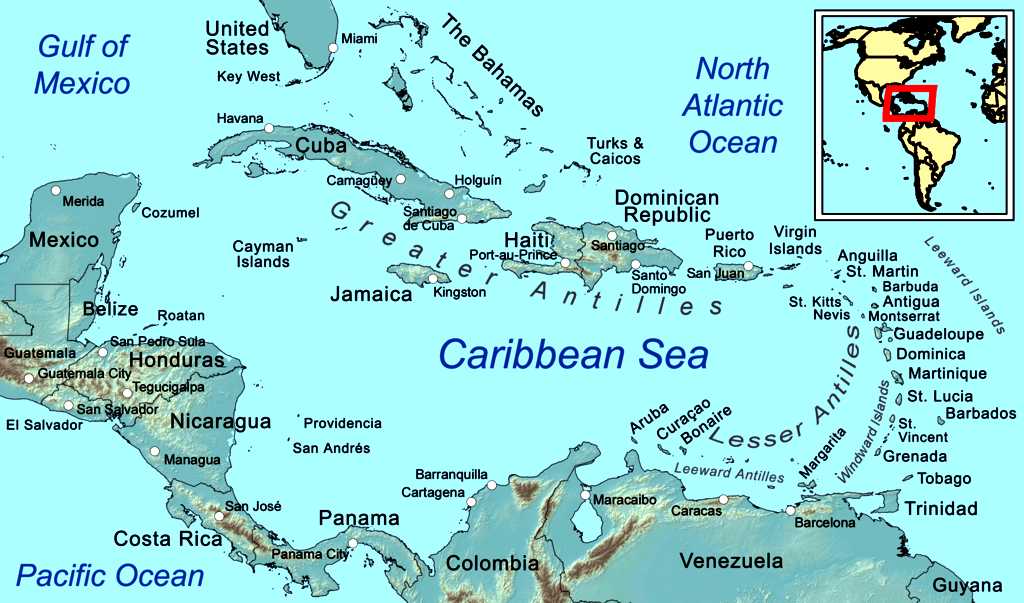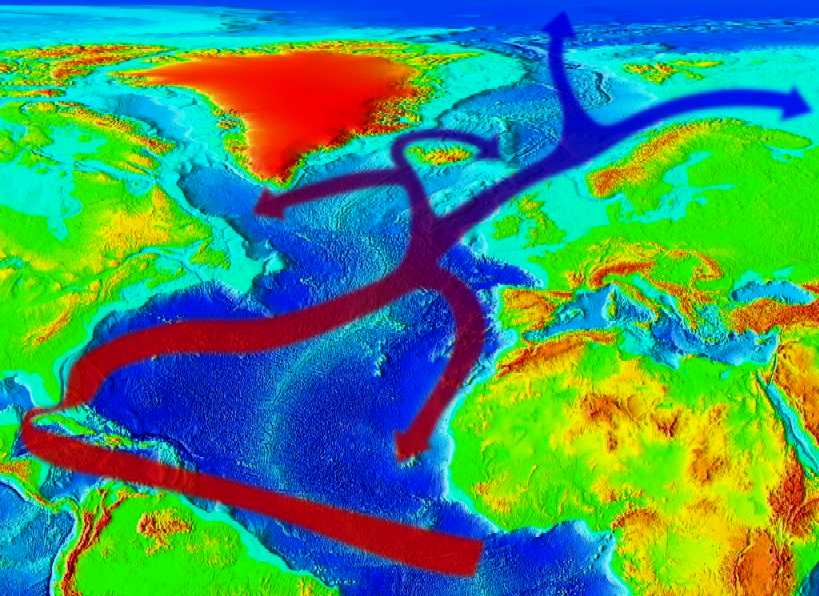|

What
is brown and stinks? G7 climate policies - the proof of which is the
sargassum state of emergency
THE
SARGASSUM SEASON 2022
The 2022 sargassum season began at the beginning of spring due to a rise in sea temperature, which accelerates the reproduction of the seaweed. As the days get warmer, the presence of sargassum is expected to increase. Beaches with the highest seaweed count include Playa del Carmen, Tulum, and some points between Cancun and Puerto Morelos.
The Mexican government and hotels in the Yucatan Peninsula have stepped up their efforts to tackle it, however, the majority of low-budget hotels and hostels do not have the means to
clean their beaches on a daily basis.
If you’re keen to avoid sargassum on your Mexico visit, make sure to stay in a hotel that has staff constantly monitoring the ever-changing situation and has the means to tackle the issue.

Pristine
white sand beaches like this will eventually become soiled
NEWS ON SARGASSUM SEAWEED
Rear Admiral César Gustavo Ramírez Torralba, Coordinator of the Sargassum Attention Strategy and Secretary of the Navy, has reported that in the coming days, a barrier will be stationed in front of Puerto Morelos.
In the first week of April the sea barrier will be installed in Playa del Carmen, and again in Tulum in the second week of April. In Mahahual, progress stands at 500 meters of installation, with completion expected this week. Rear Admiral López added that sargassum collection vessels will also be used at sea to catch sargassum before it reaches the coast.
One
can imagine the cost of diesel
bunker heavy oil
fuels being used in such operations. Ironically, all adding to climate
change and carcinogenic
particulates.
The Governor of the state of Quintana
Roo, home to the Riviera Maya, has commented:
“We know this is a natural phenomenon that generates adverse conditions, but we will be working with the Secretary of the Navy, the municipalities, hotels and the private initiative with our best efforts to keep the beaches clean so that they continue to be a great tourist
attraction.”
According to Rear Admiral César Gustavo Ramírez Torralba, Coordinator of the Sargassum Attention Strategy and Secretary of the Navy, Cancun, Riviera Maya region forecasting less Sargassum
Seaweed in 2021.
Torralba announced that 9,320 meters (30,578 feet) of containment barriers were installed just off the beaches of Puerto Morelos, Solidaridad, Tulum, and Mahahual and Xcalak and 11 vessels will be dedicated to the purpose in shallow waters off the coasts of Benito Juárez (Cancún), Puerto Morelos, Solidaridad (Playa del Carmen), Tulum and Othón P. Blanco (Mahahual, Xcalak).
Additionally, this year (2021), an ocean vessel will be incorporated that will allow collection from the sea in various areas, depending on the largest sargassum concentrations.
But again, these will be diesel
powered. We doubt very much that the players have considered hydrogen,
let alone planned for the transition. But maybe they will catch up, or
even overtake the efforts of Ursula
von der Leyen, with her €300
billion investment in hydrogen, to rid the European Union of reliance
on Russian
fossil fuels.

FT
FINANCIAL TIMES - 2019 - MEXICAN TOURIST INDUSTRY COUNTS COST AS SEAWEED COVERS BEACH
Since 2011, sargassum has been strangling some of Mexico’s best-loved beaches in increasingly large amounts, causing not just a stink and an eyesore but damaging coral reefs and marine ecosystems.
Mexico’s Yucatán peninsula is particularly exposed, but the seaweed has been clogging up beaches across the Caribbean and Florida in a
man-made catastrophe of rising proportions. But the arrival of an island of seaweed about the size of Jamaica is a worrying escalation.
“This is the biggest environmental disaster for Mexico — these are some of the most biodiverse areas in the world,” said Esteban Amaro, a hydrobiologist monitoring the seaweed.
Stephen Leatherman, a beach expert at Florida International University, agreed. “There’s been nothing like this in the past, to my knowledge. This much sargassum is a disaster,” he said.
“If we don’t do something about it soon, the damage will become irreversible . . . in years, not decades,” added Brigitta van Tussenbroek of the seagrass laboratory at Unam university in Mexico City.
Sargassum has been observed in the Atlantic since the time of the conquistadores, but massive deforestation in the
Amazon to clear land for farming, and intensive use of fertilisers, have pumped nitrogen into the oceans, boosting algae growth. Helped by warmer ocean temperatures, scientists say, the amount of seaweed has exploded.
At sea, sargassum is alive and provides a habitat for turtles and fish. But once it comes ashore and dies, it produces toxic gases and leaches
acid and heavy metals back into the sea, altering the water’s pH and depriving the oceans of
oxygen. That has led to the spread of white syndrome, an aggressive coral disease, Mr Amaro said.
Andrés Manuel López Obrador, Mexico’s president, has mobilised the Mexican marine corps to combat the
algae with measures such as seaweed-catching ships and barriers. He is budgeting $2.7m to tackle the problem.
But this is less than a tenth of what hoteliers on the affected coast expect to pay for cleaning beaches this year. The president — who has already angered the $23bn
tourism industry by scrapping the tourist board in an austerity drive — has also incensed local businesses by saying the seaweed’s impact on the region — which accounts for half of tourism’s 8.7 per cent contribution to GDP — was “not very serious”.
As the summer holiday season starts, public opinion is also at odds with Mr López Obrador: half of respondents in a survey by pollster Mitofsky saw sargassum as a serious, national problem. Tourism is the third biggest revenue earner behind car manufacturing and remittances.
Hoteliers fear that, if Mexico fails to combat the seaweed, tourists will choose resorts elsewhere in the Caribbean, such as the
Dominican
Republic, which has successfully combated the algae with sea barriers.
At Akumal bay, near Tulum, tourists enjoy cocktails overlooking a clean beach and clear waters — but achieving that is an endless battle that can cost each hotel 1m pesos ($52,000) a month, said David Ortiz Mena, president of the Tulum Hotel Association.
“Hotels are investing unsustainable sums in fighting sargassum,” he added. “Some nights we remove 400 cubic metres . . . a lot of people are overwhelmed.”
Along Tulum’s beachfront, some hoteliers are considering closing because the beach
weddings — a mainstay of their trade — have dried up.
Francesca Pesaresi, owner of the María del Mar hotel, which has nine luxury suites, said the situation was “pretty disastrous”. Advance bookings had fallen by 80 per cent and overall occupancy was a quarter down on last year.
“We pay 3 per cent tourist tax and tourists pay a departure tax — if just 1 per cent of this were used to fight sargassum, it would be a huge help,” she said. “Sargassum is going to be here forever. It’s killing our seas and
coral.”
Hoteliers on the Riviera Maya, which stretches 120km from Puerto Morelos to Punta Allen, have lost an estimated $12m this year from cancellations related to sargassum, according to industry data. But tourists already in Mexico were putting on a brave face.
“We knew about it, we read about it, but it’s very different to actually be here seeing it, smelling it,” said Ben Brenson, an aircraft ground worker from Chicago who acknowledged that, had he not been attending a
wedding, “we probably would have chosen a different destination”.
“I guess this is what we’re doing to nature,” he said. “It’s our own doing and people don’t realise it.”
https://www.ft.com/content/80e09a68-9b88-11e9-9c06-a4640c9feebb

Map
of the Caribbean Sea, with inset showing world location. The Caribbean Sea region is located southeast of the Gulf of Mexico and the North American mainland, east of Central America, north of South America and West of the Atlantic Ocean.
In
2022, Caribbean islands were again engulfed in sargassum,
from the Sargasso Sea. Sargassum showed up briefly in the Caribbean in
2011 and had a massive comeback in 2015, which continued each summer
through 2021. Now it’s back in 2022, and sure to increase as climate
change continues to warm the
oceans.
“In all regions combined — the tropical Atlantic, the Caribbean Sea
and the Gulf of Mexico — the total sargassum amount increased from 18.8
million tons in May 2022 to 24.2 million tons in June 2022, thus setting a
new historical record,” the University of South Florida Optical
Oceanography Lab reported.
Hard hit this year are fishermen (the stuff gets tangled in fishing lines
and engine rotors), tour boat operators, beachfront resorts, restaurants
and attractions along portions of the coastlines of Barbados, the Cayman
Islands, the Dominican Republic, Puerto Rico, St. Maarten/Martin, Jamaica
and the Mexican Caribbean.
CARIBBEAN
ISLANDS - WEST INDIES
The region, situated largely on the Caribbean Plate, has more than 700 islands, islets, reefs and cays (see the list of Caribbean islands). Three island arcs delineate the eastern and northern edges of the Caribbean Sea: The Greater Antilles to the north, and the Lesser Antilles and Leeward Antilles to the south and east. Together with the nearby Lucayan Archipelago, these island arcs make up the West Indies.
The Bahamas and the Turks and Caicos Islands are sometimes considered to be a part of the Caribbean, even though they are neither within the Caribbean Sea nor on its border. However, The Bahamas is a full member state of the Caribbean Community and the Turks and Caicos Islands are an associate member. Belize, Guyana, and Suriname are also considered part of the Caribbean despite being mainland countries and they are full member states of the Caribbean Community and the Association of Caribbean States. Several regions of mainland North and South America are also often seen as part of the Caribbean because of their political and cultural ties with the region. These include Belize, the Caribbean region of Colombia, the Venezuelan Caribbean, Quintana Roo in Mexico (consisting of Cozumel and the Caribbean coast of the Yucatán Peninsula), and The Guianas (Guyana, Suriname, French Guiana, Guayana Region in Venezuela, and Amapá in Brazil).
ECOLOGY
The Caribbean is home to about 9% of the world's
coral reefs covering about 20,000 square miles (52,000 km2), most of which are located off the Caribbean Islands and the Central American coast. Among them stands out the Belize Barrier Reef with an area of 96,300 ha which was declared a World Heritage Site in 1996. It forms part of the Great Mayan Reef also known as the MBRS and being over a thousand km in length is the world's second longest. It runs along the Caribbean coasts of Mexico, Belize, Guatemala and Honduras.
The habitats supported by the reefs are critical to such tourist activities as fishing and diving, and provide an annual economic value to Caribbean nations of $3.1-$4.6 billion. Continued destruction of the reefs could severely damage the region's economy. A Protocol of the Convention for the Protection and Development of the Marine Environment of the Wider Caribbean Region came in effect in 1986 to protect the various endangered marine life of the Caribbean through forbidding human activities that would advance the continued destruction of such marine life in various areas. Currently this protocol has been ratified by 15
countries. Also several charitable organisations have been formed to preserve the Caribbean marine life, such as Caribbean Conservation Corporation which seeks to study and protect sea turtles while educating others about them.

The
Gulf (Golfstream) Stream
LINKS
& REFERENCE
http://www
ACIDIFICATION
- ADRIATIC - AEGEAN
- ARCTIC
- ATLANTIC - BALTIC
- BAY BENGAL - BAY
BISCAY - BERING
- BLACK - CARIBBEAN - CORAL
- EAST CHINA - ENGLISH
CH -
FINLAND - GOC
- GULF GUINEA - GULF
MEXICO - GULF THAILAND - GULF
TONKIN - INDIAN -
IONIAN
- IOC
-
IRC
- IRISH
- MEDITERRANEAN - NORTH
SEA - PACIFIC - PERSIAN
GULF
SEA JAPAN
- STH
CHINA - PLASTIC
- PLANKTON - PLASTIC
OCEANS - RED - SARGASSO
- SEA
LEVEL RISE - SOUTHERN
OCEAN - TYRRHENIAN
- UNCLOS
- UNEP
WOC
- WWF
CONTACTS
| OCEANS
|



